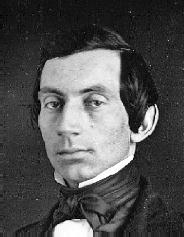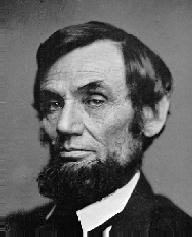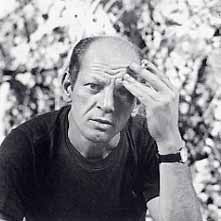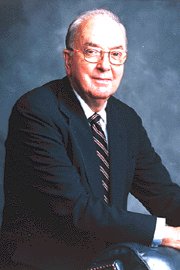

Links for Exam III


www.daguerre.org is a very handsomely done page provided by The Daguerreian Society in Pittsburgh that has numerous high-quality images within its many galleries, as well as ample information on this early form of photography.
For a bit of intrigue worthy of an entire episode of Antiques Roadshow, check out www.lincolnportrait.com, in which Mr. Kaplan, the owner of this early daguerreotype of an unknown man (left) makes a case for this being perhaps the earliest surviving photograph of Abe. What do you think? This is why provenance is so important! By the way, Mr. Kaplan e-mailed me recently to say thanks for this link.
What is believed to be the world's oldest photograph, an 1825 experiment by Daguerre's friend Niepce, sold at auction recently for about $400,000. Here's a CNN story with more details, and a picture of the picture, which is itself a picture of a picture, as Niepce chose to photograph a pen and ink drawing of a boy leading a horse.
Here's a pretty sober site on absinthe, or the "Green Fairy" (la Fée Verte), which was such an important part of late 19th century Paris (and New Orleans, and London...), and which is making a comeback, despite being illegal in most of the world (thanks in part to Kylie Minogue and the recent success of Moulin Rouge). As the authors of this site make clear, this is still a rather dangerous liqueur, and recent stories of near-death experiences of people who tried to make their own bathtub brew based on recipes found on the Internet should be a warning to all.
Mark Harden's site has a fine virtual re-creation of the landmark First Impressionist Exhibition of 1874, grouped by painter like the original show, and including numerous snippets of contemporary criticism relating to individual paintings in the exhibit. For example, go directly to his entry on Monet's Boulevard des Capucines (shown here and Ill. 27-59 in your text) and read some of Louis Leroy's famous invented dialogue between himself and his friend, Mr. Vincent. You can also read several contemporary critical reviews (including Leroy's) in their entirety, with several relevant images hyperlinked. The more you read, the more you'll realize that many in the press were actually relatively receptive to this new art in 1874..It just didn't sell much at first, and Monet and several other Impressionists remained poverty-stricken for some time afterwards.
The Metropolitan Museum of Art in New York has a nice page devoted to the life and times of the American expatriate impressionist Mary Cassatt. The nicely-done "times" and "glossary" sub-pages are particularly relevant to our discussion of her.
CGFA - As mentioned before, Carol Gerten's immense site has extensive large-scale imagery and often some biographical text for many of the artists that we are currently discussing. Simply follow the "Artists Indexes" link and look for a familiar name.
Here's a nice site that delves into the mysteries of the "Golden Section" in art and architecture, beginning with the Egyptians and found in the paintings of Leonardo, Turner, and (of course) Seurat.
Done by one of his many devotees, the Vincent van Gogh Gallery has grown to include at least low-quality images of all of Vincent's oeuvre, which means that as of this week it has more than 3,700 separate pages within, and some of the scans are quite nice. Also included is a concordance for Vincent's letters to his brother Theo. At the left is the last known photograph of him, taken when he was 20. Vincent's moving letter #506 is (connected to his famous Starry Night) and is available in its entirety via this page (click on the Arles section...the yellow chair).
Here's a recent article in Metropoleparis.com about the growing tourist industry in Auvers-sur-Oise, the 19th century painters' village that is of course best known for being the last home of Vincent van Gogh. The particular logistical information (e.g., what train to take to get there) might not be of immediate value to you, but notice the author does give a fair account of what authentic parts remain and what Disney-fied parts have been invented for the growing van Gogh Impressionism tourist market. For my money, I like this Salon.com article on Auvers ("The Wizard of Oise" ... he he..) the best.
And lastly for van Gogh fans, here's the 1997 cnn.com obituary of Jeanne Calment, the 122 year-old hip-hop star and last surviving first-person witness of van Gogh's life. Almost 110 years later, she recalled him as being ""dirty, badly dressed and disagreeable."
Like so many other long-dead artists, the Post-Impressionist Paul Gauguin has his own website, as you might expect, www.gauguin.com, set up essentially to sell posters of his art. This is a little ironic, since as we saw, Gauguin was fed up with the Western world and all its new Positivist technology...Remember that it was Gaugiun who grumbled that "Civilization is what makes you sick."
The San Diego Museum of Art's Posters of Toulouse-Lautrec page reflects their fine collection, chronicling the legendary work he did in fin-de-siècle Montmartre, including his first Moulin Rouge poster of 1891 seen here.
Here's a multifarious site on Aesthetes and Decadents from Brown University that discusses everything from political context to Victorianism to Music and Drama, like Wilde's Salomé, shown here in Beardsley's illustration. Makes Marilyn Manson look rather passé, no?
Gaudiclub.com is a compex site dedicated to the many Art Noveau-inspired (but also very unique) architecture of Barcelona's beloved Antoni Gaudi. Within it, you can read more about the movement to make Gaudi a saint, as mentioned in class. And here's another site on Gaudi...a recent CNN article on the celebrations in Barcelona for the 150th anniversary of his birth.
In a sort-of spirit of glasnost, the Cleveland Museum of Art is now willing to discuss at some length the unfortunate 1970 bombing of their copy of Auguste Rodin's the Thinker on this page within their website.
From the website for the National Museum of Women in the Arts (www.nmwa.org, as mentioned in class before), here's more information about Rodin's often overlooked student and mistress, Camille Claudel. She was played by Isabelle Adjani in the 1988 film (mentioned in class), but that's the real Camille in the photo on the left.
If you go to the Matisse page at Carol Gerten's site and find this painting (Femme au Chapeau / Woman with the Hat), you'll see how much easier it is to figure out what she is holding in her right hand than and see a more authentic reproduction of the stunning color Matisse found in our text. Give it the necessary time to load and have the Stokstad illustration in Chapter 28 ready when it's finished for comparison...you won't be disappointed.
Like the vangoghgallery.com mentioned above, the Museo Picasso Virtual is an ambitious undertaking that includes a year-by-year chronology of the artist's output, with hundreds of large format and high quality images available. Beware that this may take some time to load and that "international copyright laws" prevent them from providing larger illustrations of his works--something that's not yet stopped the Van Gogh Gallery online.

For some pulse-quickening Late Belle Epoque modernist prose, here's a link to the complete text of Filippo Marinetti's 1909 Futurist Manifesto (here translated as the Joy of Mechanical Force). Stay tuned until the end, when Marinetti offers up his eleven-point guideline, stating for example that "We want to demolish museums, libraries...(point 10)" Notice also that they don't have very nice things to say about women.
Wassily Kandinsky's legendary book Concerning the Spiritual in Art continues to affect students of painting, as is evidenced in the many five-star reviews found at this page on Amazon.com.
Try this link for a collection of Dada Poetry Number 17 is the full text of Hugo Ball's "Karawane" that is also found in your text [Fig. 28-60] and shown here above.
Read more about how Marie Osmond (yes, you read that right) recited Hugo Ball's Dada Poem "Karawane" in 1984 on the short-lived Ripley's Believe It or Not show, which was apparently having some fun with "wacky" Dada poetry. Marie took it more seriously than you might have expected, and turned in a passionate and complete reading of the poem, done without cue cards, it seems. Ba-umf! Hear her entire reading here. It is also found on on the CD that accompanied the first printing of Greil Marcus' 1989 book Lipstick Traces: A Secret History of the 20th Century.
Here's one of many good sites on Walter Gropius' Bauhaus, set up by some of the many designers who remain in its debt.
The latest Hollywood treatment of an artist is Salma Hayek's recent movie Frida (the first such movie on the Mexican Surrealist Frida Kahlo) which has been getting pretty good reviews since it was released in October.
After his attempted suppression of all avant-garde art in Germany (see page 1097 on the Entartete Kunst exhibition), Adolph Hitler instituted one (and only one!) style of painting for his Third Reich, called "Social Realism." Here's a page with some paintings from this era, such as this one showing troops passing through Langhans' Neoclassical Brandenberg Gate. As with all successful propaganda, the message in these paintings is unambiguous and repetitive.
Artcyclopedia.com has a small page on American Regionalism, with images like the most famous one of all, Grant Wood's American Gothic of 1931. Above is a more contemporary version of it.
And here's the most recent:
On a more serious note, see the complete set of photos made by Dorothea Lange the day she visited this migrant mother and her family in March of 1936, culminating in this famous image from your text. Since you and I own these images, they are free for the taking.

And the last of the Artist-Movies relevant to this exam...Pollock, the 2000 film directed by and starring Ed Harris. The official site for the film is still around. Above (R) is a recent Pollock stamp issued by the U.S. Post Office that cleverly has removed all evidence of the artist's standard cigarette-dangling-from-the-lips (L) in order to make it more politically correct! Here's more on this issue.
"Flash Mobbing" is the new term for the relatively innocent and prankish revival of Happenings that have popped up lately with the aid of today's instant messaging and e-mail. Here, a number of total strangers have followed orders to meet at the rug department at Macy's in NYC and debate the merits of a particular rug. Despite the First Amendment's guarantee of the right of people to peaceably assemble, security guards in situations like this are usually very confused and concerned. For more on this event, and others, see this site, from which this picture was taken. For a news story on such events, see this page.
PBS still has a nice page on the legendary Robert Rauschenberg connected to the American Masters special on him a few years ago. Above is his Canyon (ill. 29-23), one of his famous "combines."
Although Andy Warhol might have suggested that the secret to him was all on the surface, the nearby Andy Warhol Museum in Pittsburgh does a nice job in its ongoing investigation of this media-savvy Pop Artist--there's a lot of "surface" there to examine. Note that they don't show a whole lot of his work on their website, though--they want you to go there, of course, and so do I.
And here's a page with some of Warhol's outrageous (but usually very honest) quotes about art, especially the famous "Pop Art is about liking things" one.
The controversy surrounding Richard Serra's Tilted Arc installation and eventualy dismantling is a complicated one and is discussed at some length (well, at greater length than in Stokstad, page 1176) at this PBS site.
If you have yet to visit Maya Lin's now-famous (once infamous) Vietnam Veterans Memorial in Washington, D.C., you can in the meantime visit it virtually via the nice www.thevirtualwall.org site. The site is updated each day to feature the names of those soldiers who died on that day. Also, PBS has a site (like the one above for Serra's Tilted Arc) that deals with the issues that made this great commission so controversial (for anti-Minimalists like Pat Buchanan at least) twenty years ago.
Several other Cindy Sherman photographs can be viewed at the Masters of Photography site, starting with her Untitled series from the late 1970s (Ill. 29-74 shown here).
Also, check out Jenny Holzer's first Web-based project, entitled "Please Change Beliefs", where you can interact with her nifty Postmodern messaging system.
The artiste maudit stereotype doesn't have to be followed so slavishly...or so thinks Thomas Kinkade, the "best-selling living artist in the world." So, get a mug of hot chocolate (with extra fluffy marshmallows), sit down, and feel the magic. See more of his work by going to this site for a local gallery in Mentor, Ohio specializing in his prints. Note also that the artist has annotated his feelings about each image. You can also go to his official website, www.thomaskinkade.com (c'mon, you knew he had to have a website!). By the way, his sales dropped a bit recently before interest in his work was renewed by the recent 60 Minutes profile (arguably not the intention of 60 Minutes, if you saw the profile!). For the six months prior to that, he had sold a disappointing $49.1 dollars of originals and (mostly) reproductions, less than his Wall Street investors had hoped for. Part of Kinkade's grand vision is to build homes that look like this....I'm not kidding. And finally, check out what Kinkade has to say about Jackson Pollock in this article...he sees a link between Pollock and Columbine.......

Yes, Senator Jesse Helms (L) did call the artist Andres Serrano a "jerk" on the senate floor in 1989, during one of the many battles in the so-called "Cultural Wars."
The arts don't get much federal funding in the United States, as can be detected in the low-tech website that the NEA (the National Endowment for the Arts) maintains.
Question: How much tax money per person on average goes to the federal funding of art? This 2001 editorial (in favor of more funding for the NEA than currently exists) has some recent statistics on this